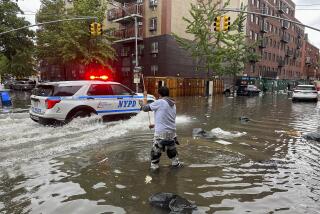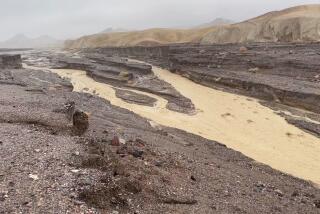Ida’s remnants close roads, prompt concerns of dam failure in Pennsylvania

- Share via
HARRISBURG, Pa. — Soaking rains from the remnants of Hurricane Ida prompted the evacuations of thousands of people Wednesday after water reached dangerous levels at a dam near Johnstown, Pa.
The storm moved east in the evening, with the National Weather Service confirming at least one tornado and social media posts showing homes blown to rubble and roofs torn from buildings in a southern New Jersey county just outside Philadelphia.
Pennsylvania was blanketed with rain after high water drove some from their homes in Maryland and Virginia. The storm killed one person, two people were not accounted for, and a tornado was believed to have touched down along the Chesapeake Bay in Maryland.
Ida caused countless school and business closures in Pennsylvania. About 150 roadways maintained by the Pennsylvania Department of Transportation were closed and many smaller roadways also were impassable. Some 18,000 customers were without power, including some 12,000 in central Pennsylvania.
Some areas near Johnstown, whose history includes several deadly floods, saw 5 inches or more of rain by midafternoon, an inundation that triggered an evacuation order for those downstream from the Wilmore Dam.
Cambria County emergency management director and 911 center head Art Martynuska said the water level at the Wilmore Dam reached a height that required evacuation.
Nearby Hinckston Run Dam was also being monitored but appeared stable by late afternoon, he said, by which time water levels at Wilmore Dam were receding.
“If that trend continues we’ll be allowing folks to return back to their residences shortly, hopefully by this evening,” Martynuska said.
Both dams were considered high-hazard dams that are likely to threaten lives were they to fail.
Evacuees were taken to a nearby high school with help from the Red Cross, National Guard, local transit authority and school transportation services, Martynuska said.
The 1889 Johnstown flood killed 2,200 people, a disaster blamed on poor maintenance on the South Fork Dam on the Little Conemaugh River. It sent a 36-foot wall of water roaring into a populated area at 40 mph.
The National Weather Service had predicted flooding from what remained of Hurricane Ida, saying steep terrain and even city streets were particularly vulnerable to a band of severe weather that extended from the Appalachians into Massachusetts.
Flash flooding knocked about 20 homes off their foundations and washed several trailers away in Virginia’s mountainous western corner, where about 50 people were rescued and hundreds were evacuated. News outlets reported that one person was unaccounted for in the small mountain community of Hurley.
Water had almost reached the ceilings of basement units when crews arrived at an apartment complex in Rockville, Md., on Wednesday. A 19-year-old was found dead, another person was missing, and about 200 people from 60 apartments near Rock Creek were displaced, Montgomery County Fire Chief Scott Goldstein said Wednesday.
“In many years I have not seen circumstances like this,” Goldstein said.
Tropical Storm Larry was strengthening and moving quickly westward after forming off the coast of Africa earlier Wednesday. Forecasters predicted it would rapidly intensify in a manner similar to Ida, becoming a major hurricane with top wind speeds of 120 mph by Saturday. Kate remained a tropical depression and was expected to weaken without threatening land.
More to Read
Sign up for Essential California
The most important California stories and recommendations in your inbox every morning.
You may occasionally receive promotional content from the Los Angeles Times.













